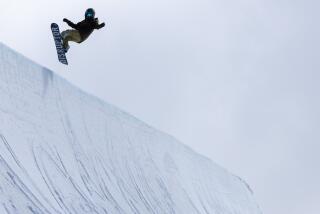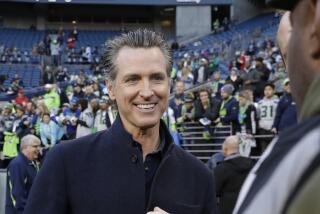Helmet Safety Is Teenager’s Life
- Share via
Brett Santos knows all the excuses for not wearing a safety helmet. They’re uncomfortable. Hot. Too expensive. And definitely not cool. But the Mission Viejo teen thinks he also has the perfect response: “It’s cooler than a coma.”
Brett, 17, was not wearing a helmet in June 1997 when he fell off his skateboard and slammed his head on the pavement. He spent two weeks in an induced coma, a tube draining fluid off his swollen brain. After a painful recovery that included learning how to walk again, Brett has become an activist: He speaks to youth groups, kids at schools, anywhere he can get them to think about the importance of helmet safety.
With the help of his parents, Brett hopes that his safety awareness campaign will prompt the nation’s safety watchdog group, the U.S. Consumer Product Safety Commission, to expand the list of sports that experts believe require safety helmets. The commission recently recommended that snowboarders take the precaution, but have no formal position on whether skateboarders and in-line skaters should do the same.
The safety issue takes on greater significance as cities throughout Southern California are poised to build unsupervised parks for skateboarders and in-line skaters, with four in South County alone. Statewide, more than 50 such parks are in the works.
Each year, about 120 youths nationwide die from head injuries that occur while they are not wearing helmets, which, when worn, reduce the risk of head injury by up to 85%, according to the safety commission. Opponents of helmet laws say that although any death is regrettable, the number of fatalities do not support mandating safety gear.
Last month, a 13-year-old Aliso Viejo youth died after a skating injury. Michael O’Bannan was on his skateboard, holding onto his father’s truck as it pulled away, when he fell and cracked his head on the pavement. After a week in a coma, Michael died.
“My heart broke,” recalled Mary Kay Bader, the neuro-clinical nurse specialist who cared for Michael at Mission Hospital Regional Medical Center in Mission Viejo. She believes a helmet may have prevented his death, and she would like to see a state law mandating helmet use for skaters. “There is a serious problem with [in-line skating] and skateboarding injuries,” she said.
California’s newest crop of skate parks can be traced to a 1998 law that limits who can sue cities and counties for injuries that take place in skateboarding parks.
Some officials believe that the very nature of skate parks--a place designed for skaters--offers a measure of safety. Common sense should take care of the rest, they say.
“We want people to voluntarily comply,” said Bruce Wegner, a recreation director for San Clemente, which is planning a skate park where helmet use will be recommended but not required. “Obviously you need to be careful when you’re dealing with children. I know my kids are required to wear helmets when they skate.”
Brett’s father questions the wisdom of not requiring helmets.
“Skate parks aren’t the answer,” said David Santos. “It doesn’t speak to safety. Let’s not make more areas where kids can hurt themselves. It just makes more sense to me to say, ‘Wear a helmet.’ ”
The Santos family has made it their goal to get a statewide helmet law passed, a daunting task in California, where residents cherish their freedom. The controversial 1994 law requiring helmets for cyclists passed the assembly by a six-vote margin and in the face of considerable opposition.
State Sen. Bill Morrow (R-Oceanside), author of the law responsible for the increase in skate parks, said he would oppose a helmet law for skaters and skateboarders.
“That’s legislation that the government cannot practically enforce, and shouldn’t,” Morrow said. “I don’t discourage anyone from using helmets in any way. But it’s a personal freedom issue.”
Lots of young skaters agree. Jeff Sellers, 14, of Anaheim says he wouldn’t wear a helmet even if it were the law. “It bugs more than it really helps,” he said.
Madona Galos, an assistant manager at Vans Skatepark in Orange, which attracts hundreds of skateboarders each week, doesn’t wear a helmet outside the skate park, where one is required, but supports a helmet law for minors.
“I think kids should be wearing helmets,” said Galos, 24. “Kids don’t have any fear of falling.”
The number of skateboarding accidents treated at UCI Medical jlwattributed to skateboarding accidents. Neither of those children were wearing helmets.
Activists and others say that nevertheless, preventing injury should come first.
“Helmets would diminish significant injuries,” said Dr. Michael Lekawa, director of the trauma center at UCI. “Kids get injured, that just happens. But you want to keep them from seriously hurting themselves, and prevention is the answer.”
(BEGIN TEXT OF INFOBOX / INFOGRAPHIC)
Head Trauma Cases
Head injuries among those 17 and younger handled by UCI Medical Center are increasing, but skateboards account for only a small number:
Total Cases
1995-96: 155
1996-97: 187
1997-98: 220
****
1997-98 Breakdown
Auto accidents: 37%
Pedestrian: 22%
Falls: 20%
Bicycle: 7%
Assault/wound: 7%
Sports/recreation: 4%
Skateboard: 1%
Other: 2%
Source: UCI Medical Center
More to Read
Go beyond the scoreboard
Get the latest on L.A.'s teams in the daily Sports Report newsletter.
You may occasionally receive promotional content from the Los Angeles Times.










